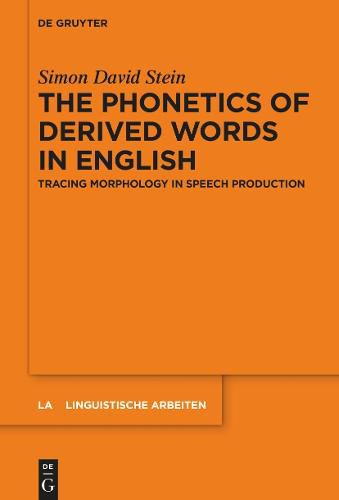Readings Newsletter
Become a Readings Member to make your shopping experience even easier.
Sign in or sign up for free!
You’re not far away from qualifying for FREE standard shipping within Australia
You’ve qualified for FREE standard shipping within Australia
The cart is loading…






This title is printed to order. This book may have been self-published. If so, we cannot guarantee the quality of the content. In the main most books will have gone through the editing process however some may not. We therefore suggest that you be aware of this before ordering this book. If in doubt check either the author or publisher’s details as we are unable to accept any returns unless they are faulty. Please contact us if you have any questions.
Effects of morphological structure on phonetic detail present us with two challenges. The empirical challenge is that some predictors have produced inconsistent effects. The theoretical challenge is that it is unclear where morpho-phonetic effects originate from. Do speakers decompose words into morphemes? Or can such effects also originate from non-decompositional structure?
This book investigates the durational properties of English derived words in four large-scale corpus studies. In the decompositional perspective, durations are modeled as a function of frequency and segmentability, prosodic structure, and affix informativeness. In the non-decompositional perspective, durations are modeled with predictors derived from linear discriminative learning networks.
Results show that the decompositional predictors are far less reliable than previously thought. Meanwhile, some non-decompositional predictors model durations successfully. Discriminative learning is shown to be a promising alternative for modeling speech production. However, the book also demonstrates that many investigated predictors are conceptually interrelated. It ultimately cautions against taking the metaphors we use to describe these predictors as final explanations.
$9.00 standard shipping within Australia
FREE standard shipping within Australia for orders over $100.00
Express & International shipping calculated at checkout
This title is printed to order. This book may have been self-published. If so, we cannot guarantee the quality of the content. In the main most books will have gone through the editing process however some may not. We therefore suggest that you be aware of this before ordering this book. If in doubt check either the author or publisher’s details as we are unable to accept any returns unless they are faulty. Please contact us if you have any questions.
Effects of morphological structure on phonetic detail present us with two challenges. The empirical challenge is that some predictors have produced inconsistent effects. The theoretical challenge is that it is unclear where morpho-phonetic effects originate from. Do speakers decompose words into morphemes? Or can such effects also originate from non-decompositional structure?
This book investigates the durational properties of English derived words in four large-scale corpus studies. In the decompositional perspective, durations are modeled as a function of frequency and segmentability, prosodic structure, and affix informativeness. In the non-decompositional perspective, durations are modeled with predictors derived from linear discriminative learning networks.
Results show that the decompositional predictors are far less reliable than previously thought. Meanwhile, some non-decompositional predictors model durations successfully. Discriminative learning is shown to be a promising alternative for modeling speech production. However, the book also demonstrates that many investigated predictors are conceptually interrelated. It ultimately cautions against taking the metaphors we use to describe these predictors as final explanations.